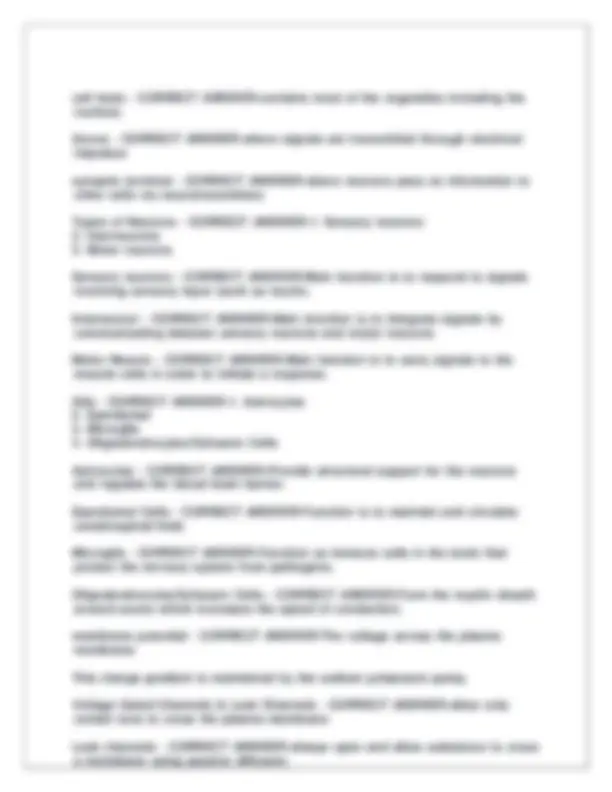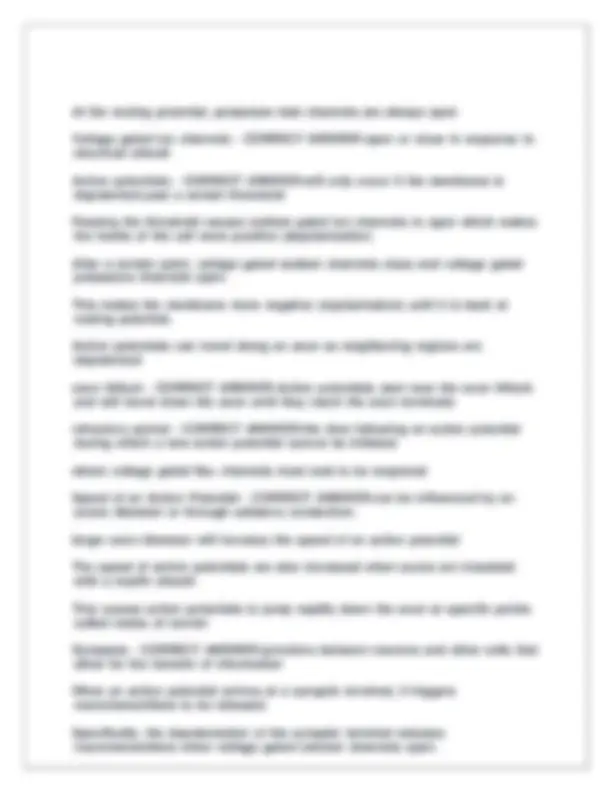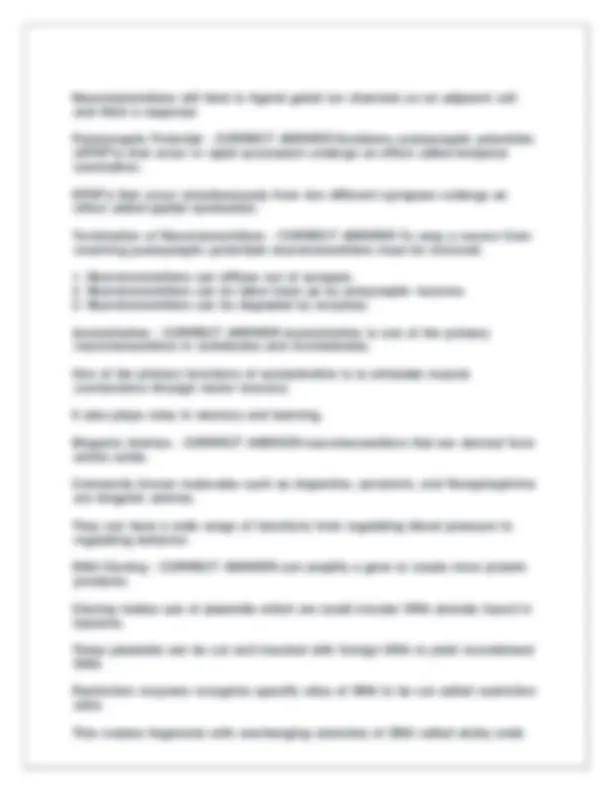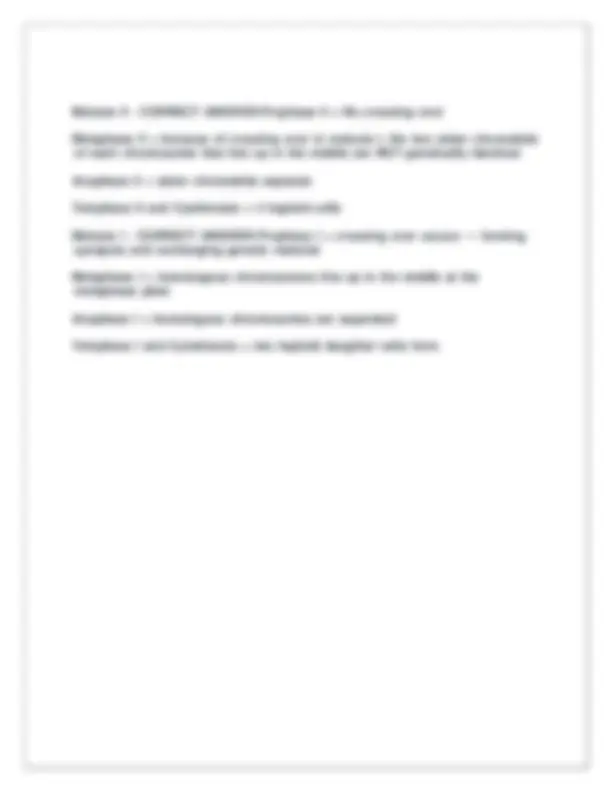






Study with the several resources on Docsity

Earn points by helping other students or get them with a premium plan


Prepare for your exams
Study with the several resources on Docsity

Earn points to download
Earn points by helping other students or get them with a premium plan
Community
Ask the community for help and clear up your study doubts
Discover the best universities in your country according to Docsity users
Free resources
Download our free guides on studying techniques, anxiety management strategies, and thesis advice from Docsity tutors
A comprehensive set of questions and answers covering key concepts in cell biology, including cell differentiation, rna splicing, translation initiation, and embryonic development. It explores the mechanisms of gene regulation, the role of transcription factors and repressors, and the processes of pattern formation and organogenesis. The document also delves into the structure and function of neurons, including the different types of neurons and the role of glial cells. It further examines the principles of membrane potential, action potentials, and synaptic transmission, including the role of neurotransmitters like acetylcholine and biogenic amines. Finally, it touches upon dna cloning and crispr-cas9 gene editing techniques.
Typology: Exams
1 / 8

This page cannot be seen from the preview
Don't miss anything!





cell .differentiation .- .CORRECT .ANSWER-Different .combinations .of .activators .and .repressors .can .lead .to .differential .gene .expression. These .different .combinations .of .transcription .factors/repressors .can .also .lead .to .cell .differentiation RNA .Splicing .- .CORRECT .ANSWER-Can .lead .to .the .formation .of .different .protein .products .from .a .single .gene mRNA .Degradation .- .CORRECT .ANSWER-Prevents .mRNA .from .being .translated. Achieves .this .through .the .removal .of .the .5' .and .shortening .of .poly-A .tail. Translation .Initiation .- .CORRECT .ANSWER-Translation .initiation .can .also .be .prevented .when .substances .block .the .mRNA .or .the .ribosome. Cytoplasmic .determinants .- .CORRECT .ANSWER-include .molecules .such .as .RNA .and .proteins .that .result .in .differential .gene .expression. Once .the .zygote .divides, .the .uneven .distribution .of .cytoplasmic .determinants .will .contribute .to .cell .differentiation Cell .Determination .- .CORRECT .ANSWER-Cells .become ."determined" .to .a .specific .cell .type .once .mastery .regulatory .genes .are .turned .on. In .the .case .of .muscle .cells .for .example, .transcription .of .the .MyoD .gene .commits .an .undifferentiated .cell .to .become .a .muscle .cell. The .MyoD .gene .codes .for .a .transcription .factor .that .activates .the .expression .of .other .genes. Induction .- .CORRECT .ANSWER-the .process .where .embryonic .cells .undergo .transcriptional .changes .after .receiving .signal .molecules .from .nearby .cells. Pattern .Formation .- .CORRECT .ANSWER-Pattern .formation .establishes .the .major .axis .and .body .segments .of .an .organism. Cytoplasmic .determinants .influence .the .process .of .pattern .formation.
Bicoid .- .CORRECT .ANSWER-Bicoid .is .a .maternal .effect .gene .that .helps .establish .the .anterior .end .of .Drosophila. Bicoid .product .is .found .at .the .anterior .end .of .the .embryo .and .is .an .example .of .a .morphogen. Morphogens .are .unevenly .distributed .substances .that .aid .in .pattern .formation. Stages .of .Embryonic .Development .- .CORRECT .ANSWER-1. .Fertilization
At .the .resting .potential, .potassium .leak .channels .are .always .open Voltage .gated .ion .channels .- .CORRECT .ANSWER-open .or .close .in .response .to .electrical .stimuli Action .potentials .- .CORRECT .ANSWER-will .only .occur .if .the .membrane .is .depolarized .past .a .certain .threshold Passing .the .threshold .causes .sodium .gated .ion .channels .to .open .which .makes .the .inside .of .the .cell .more .positive .(depolarization) After .a .certain .point, .voltage .gated .sodium .channels .close .and .voltage .gated .potassium .channels .open. This .makes .the .membrane .more .negative .(repolarization) .until .it .is .back .at .resting .potential. Action .potentials .can .travel .along .an .axon .as .neighboring .regions .are .depolarized axon .hillock .- .CORRECT .ANSWER-Action .potentials .start .near .the .axon .hillock .and .will .travel .down .the .axon .until .they .reach .the .axon .terminals refractory .period .- .CORRECT .ANSWER-the .time .following .an .action .potential .during .which .a .new .action .potential .cannot .be .initiated where .voltage .gated .Na+ .channels .must .wait .to .be .reopened Speed .of .an .Action .Potential .- .CORRECT .ANSWER-can .be .influenced .by .an .axons .diameter .or .through .saltatory .conduction. larger .axon .diameter .will .increase .the .speed .of .an .action .potential The .speed .of .action .potentials .are .also .increased .when .axons .are .insulated .with .a .myelin .sheath This .causes .action .potentials .to .jump .rapidly .down .the .axon .at .specific .points .called .nodes .of .ranvier Synapses .- .CORRECT .ANSWER-junctions .between .neurons .and .other .cells .that .allow .for .the .transfer .of .information When .an .action .potential .arrives .at .a .synaptic .terminal, .it .triggers .neurotransmitters .to .be .released. Specifically, .the .depolarization .of .the .synaptic .terminal .releases .neurotransmitters .when .voltage .gated .calcium .channels .open.
Neurotransmitters .will .bind .to .ligand .gated .ion .channels .on .an .adjacent .cell .and .illicit .a .response Postsynaptic .Potential .- .CORRECT .ANSWER-Excitatory .postsynaptic .potentials .(EPSP's) .that .occur .in .rapid .succession .undergo .an .effect .called .temporal .summation. EPSP's .that .occur .simultaneously .from .two .different .synapses .undergo .an .effect .called .spatial .summation. Termination .of .Neurotransmitters .- .CORRECT .ANSWER-To .stop .a .neuron .from .receiving .postsynaptic .potentials .neurotransmitters .must .be .removed.
Genes .located .on .the .same .chromosome .that .tend .to .be .inherited .together .in .genetic .crosses. → .linked Crossing .over .breaks .the .linkage .between .genes .on .the .same .chromosome! Allows .for .more .non-parental .phenotypes .(recombinant .offspring) Epigenetics .- .CORRECT .ANSWER-Epigenetic .tags .change .with .experiences, .environmental .interaction, .and .even .our .diet! Worker .bee. → ."Queen" .genes .turned .off Queen .bee. → .she .grows .up .in .a .queen .cup .(which .has .royal .jelly. → .opens .chromatin .structure .and .turns .on ."Queen" .genes Epistasis .- .CORRECT .ANSWER-Involves .two .or .more .genes! When .a .gene .at .one .locus .changes .the .phenotypic .expression .of .a .different .gene .at .a .second .locus Polygenic .Inheritance .- .CORRECT .ANSWER-When .MULTIPLE .gene .affects .ONE .phenotypic .trait Examples: .height, .weight, .and .skin .color .in .humans Pleiotropy .- .CORRECT .ANSWER-When .ONE .gene .affects .MULTIPLE .phenotypic .traits Example: .sickle .cell .anemia Codominance .- .CORRECT .ANSWER-Both .alleles .are .simultaneously .expressed .in .the .heterozygote. Both .alleles .affect .the .phenotype .in .separate, .distinguishable .ways! Incomplete .Dominance .- .CORRECT .ANSWER-Relationship .between .alleles, .with .a .heterozygous .phenotype .intermediate .(or .blend) .between .the .two .homozygous .phenotypes Neither .allele .is .dominant! Law .of .Independent .Assortment .- .CORRECT .ANSWER-When .homologous .pairs .line .up .in .random .orientations .at .the .middle .of .the .cell .as .they .prepare .to .separate, .we .can .get .gametes .with .different .combos .of ."mom" .and ."dad" .homologues .because .the .orientation .of .each .pair .is .random. Nondisjunction .- .CORRECT .ANSWER-Chromosome .fail .to .sperate If .nondisjunction .occurs .in .meiosis .I, .all .four .haploid .cells .will .be .affected! If .nondisjunction .occurs .in .meiosis .II, .only .two .haploid .cells .will .be .affected!
Meiosis .II .- .CORRECT .ANSWER-Prophase .II .= .No .crossing .over Metaphase .II .= .because .of .crossing .over .in .meiosis .I, .the .two .sister .chromatids .of .each .chromosome .that .line .up .in .the .middle .are .NOT .genetically .identical Anaphase .II .= .sister .chromatids .separate Telophase .II .and .Cytokinesis .=. 4 .haploid .cells Meiosis .I .- .CORRECT .ANSWER-Prophase .I .= .crossing .over .occurs. → .forming .synapsis .and .exchanging .genetic .material Metaphase .I .= .homologous .chromosomes .line .up .in .the .middle .at .the .metaphase .plate Anaphase .I .= .homologous .chromosomes .are .separated Telophase .I .and .Cytokinesis .= .two .haploid .daughter .cells .form